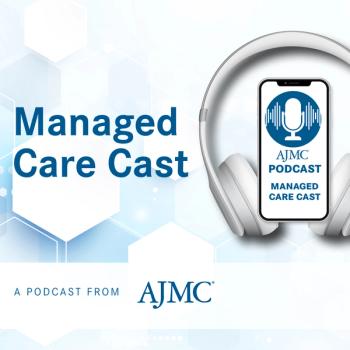
Achieving the Goals of Value-Based Care for Multiple Sclerosis
Value-based agreements come with risks and benefits, but a health system’s existing facilities and initiatives can help support the goals associated with them, JT Lew, PharmD, MBA, a managed care pharmacist at MultiCare Health System, explained.
Value-based agreements (VBAs) come with risks and benefits, but a health system’s existing facilities and initiatives can help support the goals associated with VBAs, JT Lew, PharmD, MBA, a managed care pharmacist at MultiCare Health System, explained.
In
At The American Journal of Managed Care® (AJMC®) Institute for Value-Based Medicine® event in Seattle, Washington, cohosted with Providence, Lew presented on the challenges regarding medication accessibility in the MS treatment space.
This interview has been lightly edited for clarity.
AJMC: What are the potential risks and benefits of entering into a VBA from the perspective of a health care provider treating patients with MS?
There are lots of benefits and risks. The benefits I see are being able to see both the medical and pharmacy claims data. With a payer who's covering multiple sclerosis medications, sometimes the pharmacy benefit manager can see what was dispensed on the pharmacy benefit, but not necessarily on the medical benefit, because the medical benefit is administered by an entirely different organization or a third-party administrator. Within a value-based agreement, that aligns incentives to be able to see both medical and pharmacy claims, so that providers can get a better picture of what treatments the patient has tried and what the plans have also been charged for each of those treatments on both benefits to see which one might be more affordable for the patient.
Furthermore, there's an opportunity to see how these patients are doing on these medications, with the collaboration of the provider and a health system. Having that access to the electronic health record, you can see the patient's progression over time in all of the chart notes, which really drives home the messaging of value-based care, which is to improve clinical outcomes and reduce total costs.
However, there are risks that health systems and providers might not see. One of these risks is not being able to see the net cost of what the payer is actually paying, because with how some of these contracts are negotiated, they can be often on the list price. But there have been some reports of there being discounts from rebates that the health systems or providers are not able to see, so the payer might be paying much less than what the listed price is in the claim. Therefore, not necessarily getting the whole picture.
Also, health systems might have to account for the lower reimbursement they might receive on these prescriptions and services that are provided, because for many of these patients with multiple sclerosis who are attributed to value-based agreements, they might not often be the majority of the patient population that the clinic see.
Those are some of the benefits and risks, at least that I've been currently seeing. But it'd be interesting to talk to other systems, especially around the country outside of Washington, to hear what they're seeing, too.
AJMC: How can a health system’s existing facilities and services be used to support the goals of VBAs?
For value-based agreements to work, it really requires a team approach and collaboration amongst all stakeholders within the health system, within the payer, and within the third-party administrator, just to name a name a few. And what I think of when we're talking about medications used for multiple sclerosis are health systems, especially pharmacies, and how critical they are to work with our wholesalers to help stock the preferred products that the value-based agreement wants to be shifting utilization toward, for example, in a conversion strategy. Or are there opportunities for cost savings for patients who want to explore the idea of clear bagging from the health specialty pharmacy to the infusion center that's located on campus to keep that continuity of care in house within the health system?
That brings me to my next stakeholder, the infusion centers. So, thinking about having both a hospital-based and a non–hospital-based infusion center. With certain site-of-care policies that some payers have now, there's an interest in shifting patients to non–hospital-based infusion centers, when appropriate, to reduce the total cost of care for the patient and the payer. With a lot of these medications that are used for multiple sclerosis, they can have a higher risk of adverse effects, especially with the higher-efficacy products. Having the opportunity to monitor them in a hospital-based infusion center and see how they do, and then approaching the idea of asking them if they they're interested in moving to a non–hospital-based Infusion center after it's determined that they can tolerate the medication well and they're comfortable with receiving the infusion, could be a savings opportunity for the patient that the patient might want to take advantage of.
I don't want to forget about our frontline staff members, either—for example, our clinical-embedded pharmacists that are embedded in, for example, the neurology clinics. And also, there's some health systems that have specialty pharmacists who are embedded in some of these specialty clinics, too, and they really help provide the providers with support, whether it's drug information questions or even to the point of managing patients through a collaborative drug therapy agreement to help them mitigate side effects, and also help with some of those access issues, too—overall, just being a resource and extension of the clinic when the provider is not available, that is a huge win for the patient.
Last but not least, I can't forget about our patient assistance teams and our care navigators, who I view as the champions for being able to help patients better understand what options they have for affording their medications and navigating through all the prior authorization calls and the step therapy calls with the insurance companies to really advocate for the patient for the therapy that the provider wants the patient to be on.
AJMC: How can health care providers effectively connect patients with MS with resources for financial assistance and medication access?
I can't drive home this point enough about patient assistance teams and care navigators, not only within the health system, but within nonprofit organizations such as the National Multiple Sclerosis Society, too. Not only will these care navigators help navigate medication access, but within these nonprofit organizations, they're genuinely invested in trying to help these patients better understand what all of their options are. For example, that even goes down to the point of looking at, “How can we better plan for open enrollment the next year to help you find a health plan that your employer offers that would be the best fit for you to be able to afford these anticipated medication costs that you might experience next year?”
Last but not least, health care providers can encourage patients to explore patient support groups. Oftentimes, patients might think that they're the only ones going through these access challenges or the side effects that they might experience with a medication used for multiple sclerosis. However, these patient support groups offer an opportunity for these patients to talk with others who might have experienced something similar within their journey to access the therapy and/or achieve good or bad outcomes and ask how they would have done things differently if they were to go back and do this again.
Those are just a few of the ways that health care providers can connect patients with multiple sclerosis with resources, both for financial assistance and medication access.
Newsletter
Stay ahead of policy, cost, and value—subscribe to AJMC for expert insights at the intersection of clinical care and health economics.









































